UPDATE, 1/6/23: On January 3, 2023, the Biden FDA moderated the REMS safety requirements for the abortion pill to allow the deadly drug to be sold through retail pharmacies with a prescription.
As of June 30, 2022, U.S. sales of the abortion pill have now ended the lives of 5.6 million babies in the U.S. since its approval in 2000, according to updated data published by the FDA. In addition, the updated data reveals that there have now been 28 reports of deaths in patients associated with mifepristone since the product was approved in September 2000. The updated data also showed there have been 4,203 adverse events, including 1,048 hospitalizations, nearly 604 instances of blood loss requiring transfusions, and other serious complications reported, including 414 infections, with 71 being categorized as “severe based on medical review of the available case details.”*
UPDATE, 12/17/21: In 2021, the abortion pill saw its 21st anniversary since its approval in 2000, with an increased number of abortion industry schemes flouting FDA’s safety regulations. The push to lift the REMS continued despite reasons to question the abortion pill’s safety.
In April of 2021, the Biden Administration’s FDA temporarily enabled abortion pill distribution by mail during the COVID-19 pandemic. Then on December 16, 2021 the FDA ruled to remove the in-person requirements and permanately allow the abortion pill to be shipped by mail.
As of June 30, 2021 the FDA reported mifepristone had caused 26 deaths and tragically revealed that an “estimated number of women who have used mifepristone in the U.S. for medical termination of pregnancy through the end of June 2021 is approximately 4.9 million women.
Despite the removal of a reporting requirement for adverse events (aside from death) since 2016, the FDA report also showed that 4,207 adverse effects had been reported since the pill was approved. These include 1,045 hospitalizations. 603 instances of blood loss requiring transfusions, and 413 infections with 70 being categorized as “severe based on medical review of the available case details.”
6/6/20: In the 20 years since its approval, the abortion pill has been responsible for the deaths of dozens of women and has caused thousands of serious adverse effects. Yet these complications appear to go unnoticed, and now the abortion industry is unleashing every arsenal they have to pressure the Food and Drug Administration (FDA) to remove an important safety requirement for the abortion pill.
The Risk Evaluation and Mitigation System (REMS) requires that mifepristone — one of the two drugs in the abortion pill protocol — “must be dispensed to patients only in certain healthcare settings, specifically clinics, medical offices, and hospitals, by or under the supervision of a certified prescriber.” According to the FDA, REMS is a “drug safety program that the… FDA can require for certain medications with serious safety concerns.” Only a few medications actually require REMS, but amid the COVID-19 pandemic, the abortion industry has focused more of its efforts on pushing for DIY, at-home abortions. That can’t happen if REMS continues to apply to mifepristone. Although this safety requirement exists to protect women, abortion advocates have now sued to end REMS for the abortion pill so women can access chemical abortions at home without medical personnel present.
The Abortion Pill Backstory
In what appears to be a very politicized process, the abortion pill — RU-486 — was approved in 2000 by the FDA. Tragically, shortly after the pill was approved in the U.S., women began dying.
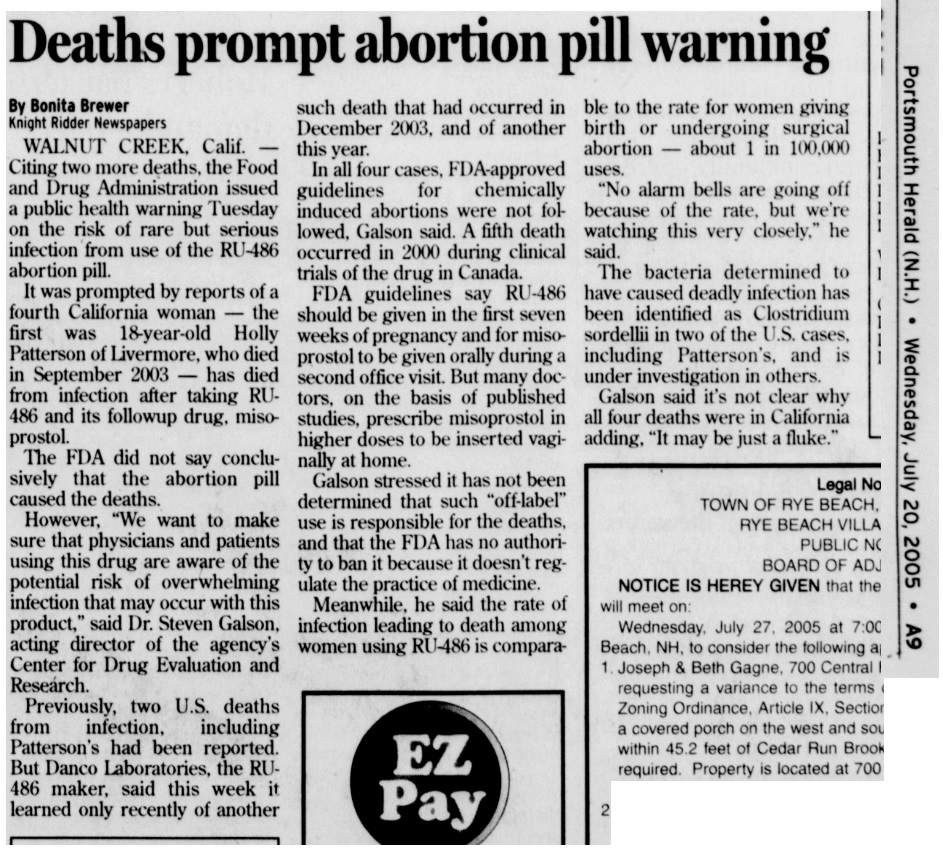
Deaths prompt abortion pill warning (Image: Portsmouth Herald 2005 )
2001:
On September 1, 2001, a woman in Canada died after taking the abortion pill. Her story barely made headlines, but her cause of death was toxic shock syndrome from a serious Clostridium sordellii infection that developed after taking the abortion pill.
2002:
By 2002, the FDA had been informed of postmarketing adverse events which included cases of ruptured ectopic pregnancy – one case resulting in death, severe systemic infection (sepsis) and a single case of a heart attack. The FDA identified off-label use of misoprostol given vaginally, not orally. Danco then published a “Dear Healthcare Provider” letter (see below), to warn of the risk.
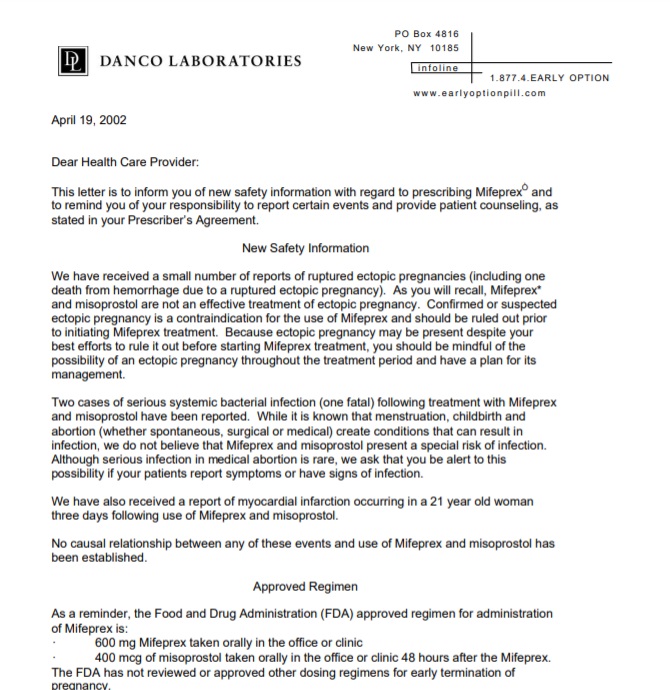
Danco Dear HC Provider letter warns that abortion pill not treatment for ectopic pregnancy 2002
2003:
Planned Parenthood’s implementation of the unapproved regimen and off-label use of the abortion pill led to the death of 18-year-old Holly Patterson from septic shock.
Patterson’s father Monty told reporters:
I learned of 10 reported deaths from sepsis (serious infection involving the blood) following medical abortions, and nine of these were from Clostridium sordelli and all involved these alternative, off-label treatments… That day in the hospital, there were officials from Planned Parenthood who showed up and said that nothing like this had happened before. I just didn’t believe it.

Monty Patterson holds up picture of his daughter Holly who died after taking abortion pill at Planned Parenthood
2004:
By 2004, the FDA announced new safety changes to Danco’s labeling of mifepristone. The warnings added new information on the risk of serious bacterial infections, sepsis, and bleeding and death. The label warned abortionists to be on alert for patients with undiagnosed ectopic pregnancies and told women to contact providers if they experienced fever, severe abdominal pain, and heavy bleeding.
Danco issued a second letter of warning, one to healthcare professionals and another to emergency room providers, and the warnings also advised ER physicians that women who have obtained chemical abortions may present to the ER with these symptoms.
2005:
In January 2005, Danco had provided additional information about the complications of abortion to all emergency room physicians and providers of the abortion pill. In July of 2005, the FDA issued a Public Health Advisory noting several deaths that “involve the off-label dosing regimen…” By November 2005, the FDA identified “four cases of deaths from infection from September 2003 to June 2005 following medical abortion with these drugs.” The FDA then updated the label and issued another Public Health Advisory “highlighting the risk of sepsis or blood infection when undergoing medical abortion…in a manner that is not consistent with the approved labeling.”
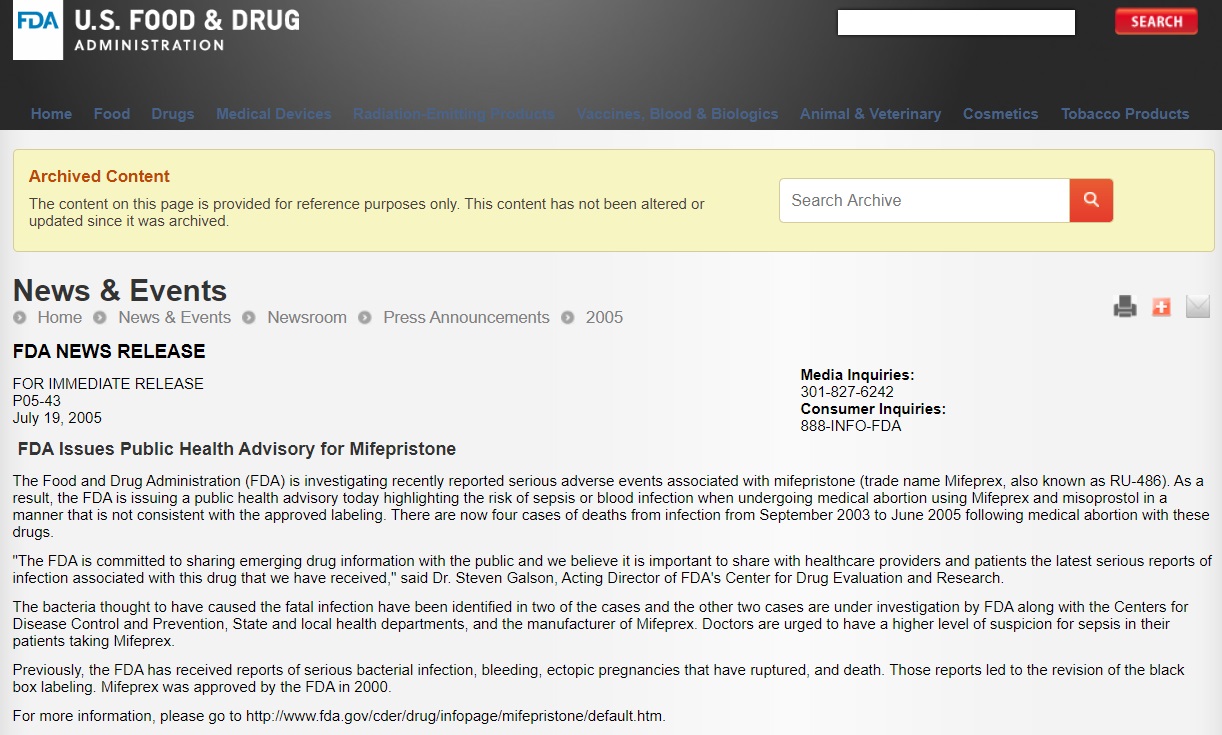
2005 FDA Public Health Advisory on several abortion pill deaths
That same year, the pro-abortion journal Contraception published a letter from abortionist Dr. Philip Darney, “Deaths associated with medication abortion,” warning that the death rate from the abortion pill among Planned Parenthood patients had reached “1.5 per 100,000 compared to a U.S. rate of .5 for early surgical abortion.” Darney served on the boards of Planned Parenthood Federation of America and the Guttmacher Institute, Planned Parenthood’s former research arm. In his letter, Darney pointed out that the U.S. death rate using the abortion pill was higher than in Europe, possibly because in the states, “US Physicians do not follow the FDA approved instructions for using both drugs.”
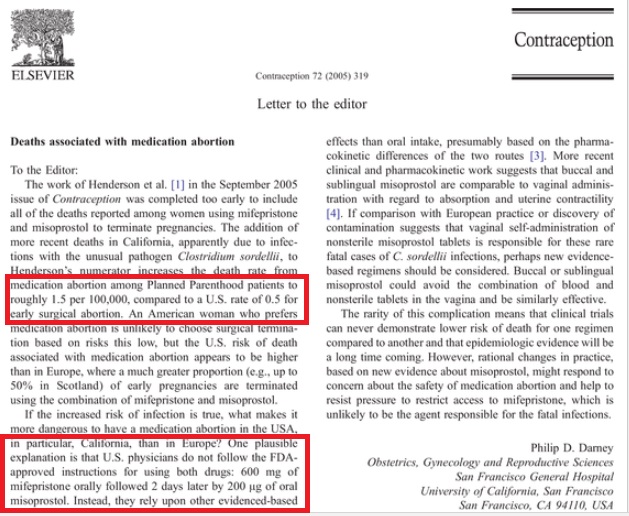
Philip D Darney on abortion pill deaths Planned Parenthood and evidence based protocols (Image credit: Journal Contraception)
Years later, a 2014 Contraception article, entitled “Reduction in infection-related mortality since modifications in the regimen of medical abortion, identified “off-label” use of the abortion pill as a cause of the deaths. The authors, including Planned Parenthood’s own Medical Director Deborah Nucatola, identified how from 2001 to March 2006 Planned Parenthood provided chemical abortions by a regimen of oral mifepristone followed by vaginal misoprostol. They added, “In response to concerns about serious infections, in early 2006 Planned Parenthood changed the route of misoprostol administration to buccal [the FDA approved method at that time] and required either routine antibiotic coverage or universal screening and treatment for chlamydia; in July 2007, Planned Parenthood began requiring routine antibiotic coverage for all medical abortions.” This change reduced the mortality rate significantly, they claimed.
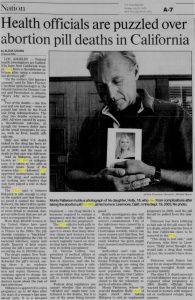
2005 abortion pill deaths (Image: The Times-Reporter)
2006:
In 2006, the FDA became aware of two additional deaths following the abortion pill regimen and in March it issued a Public Health Advisory to warn the public of the risk of sepsis associated with the abortion pill and announcing two additional deaths from the abortion pill.

2006 Abortion pill deaths (Image: Nashua Telegraph)
On May 11, 2006, the FDA, in conjunction with the Centers for Disease Control and Prevention (CDC) and the National Institute of Allergy and Infectious Diseases (NIAID), conducted a public workshop entitled, “Emerging Clostridial Disease,” during which they discussed the scientific and medical circumstances associated with reports of morbidity and mortality with Clostridium sordellii and Clostridium difficile infections connected to chemical abortions.
2007:
By 2007, the FDA published that it had identified six deaths from serious infection since the abortion pill was approved.
2010:
By 2010, the FDA identified “off label” use of the abortion pill as the cause of several serious adverse effects, including death. The FDA noted, “Since the approval of Mifeprex…FDA has been informed of eight deaths in the United States due to serious infections following medical abortion with mifepristone and misoprostol that FDA has concluded may possibly be related to the use of these drugs. These women died from sepsis…Seven cases were found to involve infection with bacteria known as Clostridium sordellii and one case involved infection with Clostridium perfringens.”
2011:
By April 2011, the FDA reported over 2,200 adverse effects. Post-marketing reports show 14 women had died, 612 were hospitalized, 339 women had experienced blood loss which required transfusions, as well as several hundred reported cases of infection, some severe.
It was in this year that the FDA determined that a REMS was necessary for mifepristone.
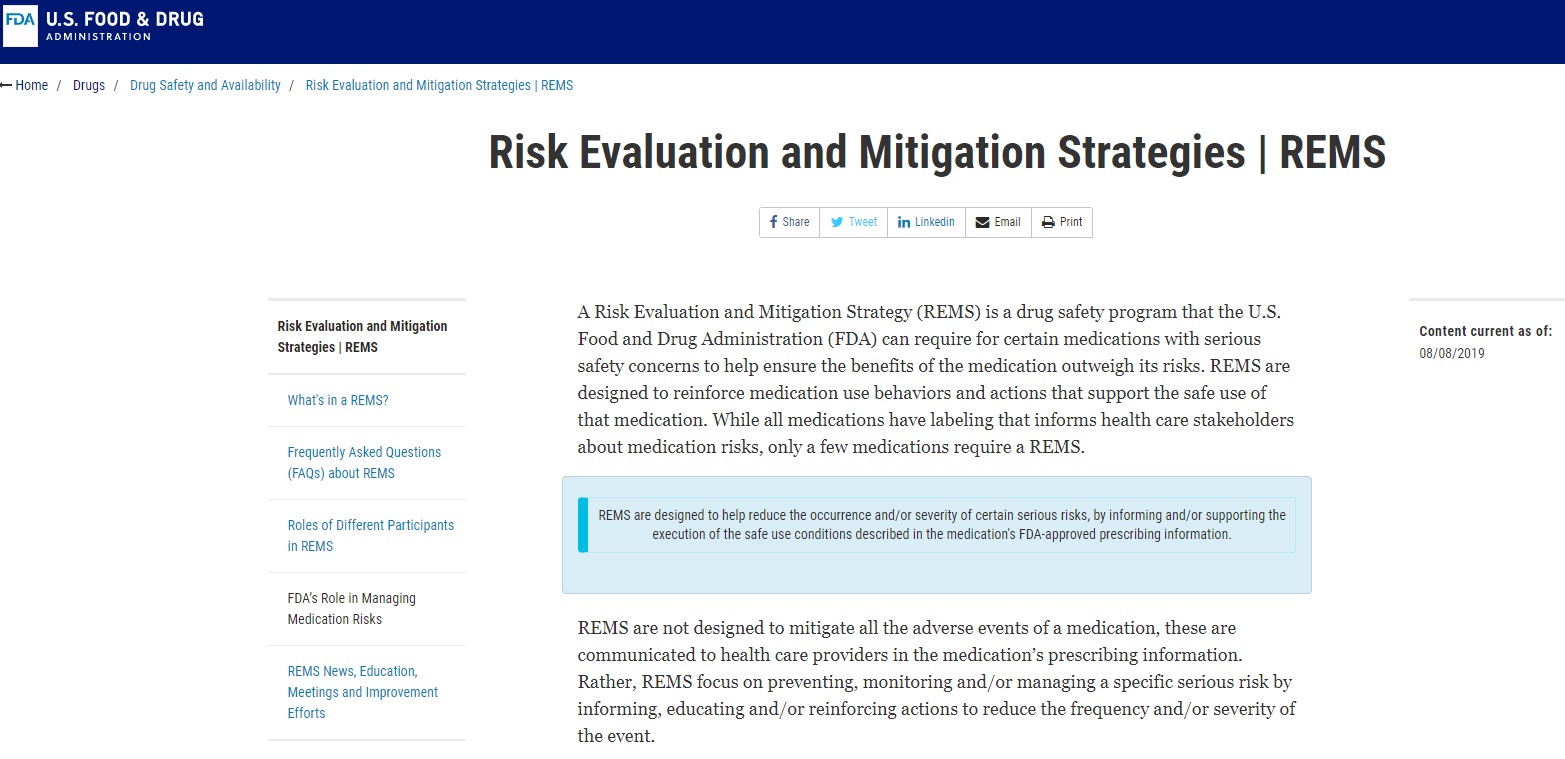
FDA REMS defined as of 6/3/2020
2016:
Despite thousands of adverse effects and additional deaths, changes made in 2016 no longer required Danco to report non-fatal adverse effects. While the abortion industry successfully lobbied to absolve their industry and the manufacturer of any responsibility to report adverse effects, it is still advisable for women or emergency room physicians to report incidents to the FDA directly. That same year, the FDA also noted, “after reviewing the supplemental application, the agency determined that a REMS continues to be necessary to ensure the safe use of Mifeprex.”
2017:
By December 31, 2017, the FDA had reported 22 deaths as well as serious complications, associated with the abortion pill.
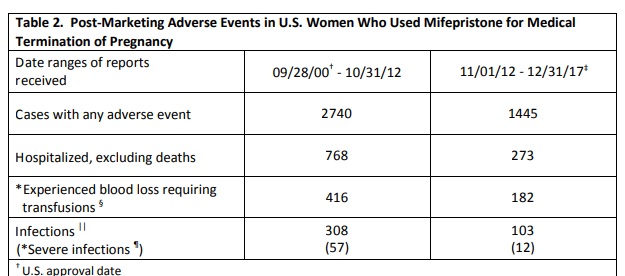
RU486 abortion pill serious adverse effects updated 2017
2018:
In December of 2018, the FDA reported 24 deaths associated with the abortion pill since its approval. Abortion pills have caused nearly 4,200 adverse effects, including 1,042 hospitalizations, nearly 600 instances of blood loss requiring transfusions, and other serious complications.
Despite all of this, Danco is no longer mandated to notify the FDA of complications, so no one may ever know just how many women have been injured by the abortion pill. In addition, the abortion pill is responsible for the deaths of about four million preborn babies.
Despite multiple requests to the FDA from Live Action News, no updates on total abortion pill numbers and deaths have been published since 2018. What is obvious, however, is that a REMS is still necessary for the abortion pill. Women should not have their health or lives put on the line because the abortion industry wants to ensure they continue to turn a profit while the COVID-19 threat lingers — and into the foreseeable future.
*THE FDA HAS RECEIVED REPORTS OF SERIOUS ADVERSE EVENTS IN PATIENTS WHO TOOK MIFEPRISTONE. AS OF JUNE 30, 2022, THERE WERE 28 REPORTS OF DEATHS IN PATIENTS ASSOCIATED WITH MIFEPRISTONE SINCE THE PRODUCT WAS APPROVED IN SEPTEMBER 2000, INCLUDING TWO CASES OF ECTOPIC PREGNANCY (A PREGNANCY LOCATED OUTSIDE THE WOMB, SUCH AS IN THE FALLOPIAN TUBES) RESULTING IN DEATH; AND SEVERAL FATAL CASES OF SEVERE SYSTEMIC INFECTION (ALSO CALLED SEPSIS). THE ADVERSE EVENTS CANNOT WITH CERTAINTY BE CAUSALLY ATTRIBUTED TO MIFEPRISTONE BECAUSE OF CONCURRENT USE OF OTHER DRUGS, OTHER MEDICAL OR SURGICAL TREATMENTS, CO-EXISTING MEDICAL CONDITIONS, AND INFORMATION GAPS ABOUT PATIENT HEALTH STATUS AND CLINICAL MANAGEMENT OF THE PATIENT. A SUMMARY REPORT OF ADVERSE EVENTS THAT REFLECTS DATA THROUGH JUNE 30, 2022, IS HERE. THE FDA HAS REVIEWED THIS INFORMATION AND DID NOT IDENTIFY ANY NEW SAFETY SIGNALS. THE FDA INTENDS TO UPDATE THIS SUMMARY REPORT AS APPROPRIATE.
“Like” Live Action News on Facebook for more pro-life news and commentary!







